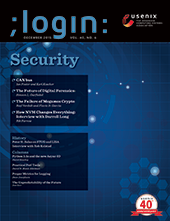
The Expanding World of Digital Forensics
;login: Enters a New Phase of Its Evolution
For over 20 years, ;login: has been a print magazine with a digital version; in the two decades previous, it was USENIX’s newsletter, UNIX News. Since its inception 45 years ago, it has served as a medium through which the USENIX community learns about useful tools, research, and events from one another. Beginning in 2021, ;login: will no longer be the formally published print magazine as we’ve known it most recently, but rather reimagined as a digital publication with increased opportunities for interactivity among authors and readers.
Since USENIX became an open access publisher of papers in 2008, ;login: has remained our only content behind a membership paywall. In keeping with our commitment to open access, all ;login: content will be open to everyone when we make this change. However, only USENIX members at the sustainer level or higher, as well as student members, will have exclusive access to the interactivity options. Rik Farrow, the current editor of the magazine, will continue to provide leadership for the overall content offered in ;login:, which will be released via our website on a regular basis throughout the year.
As we plan to launch this new format, we are forming an editorial committee of volunteers from throughout the USENIX community to curate content, meaning that this will be a formally peer-reviewed publication. This new model will increase opportunities for the community to contribute to ;login: and engage with its content. In addition to written articles, we are open to other ideas of what you might want to experience.

Digital forensics is on its way to becoming a mainstream part of computer science. With the right tools, forensic examiners can trace the source and determine the extent of a cyberattack. They can find evidence on a cell phone to help convict a bank robber or pimp. They can pull apart the firmware in cars and embedded devices, finding privacy leaks and security vulnerabilities. To accomplish this wizardry, the field has had to grow beyond its roots of simple data extraction and file system analysis, and now incorporates a wide variety of leading-edge computer science techniques, including big data analytics, visualization, multilingual processing, and program analysis. It’s never been a better time to be a digital forensics researcher—the people who are charged with discovering how to exploit new technologies and building the tools that systemize that knowledge. At the same time, increased technical complexity and diversity is making the job of front-line forensics examiners more challenging every day.
